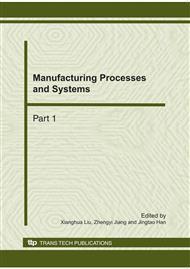p.312
p.316
p.322
p.326
p.332
p.338
p.342
p.346
p.353
Effect of Forward Extrusion and Heat Treatment on Microstructure and Mechanical Properties of as-Cast ZK60 Magnesium Alloy
Abstract:
In the present research, the influences of different extrusion ratios (15, 30, 45, 60, and 75), extrusion temperatures (300 , 340 , 380 , 420 , and 460 ), and subsequent heat treatment on the mechanical properties and microstructure of as-cast ZK60 magnesium alloy have been investigated through the tensile tests and via metallographic observation. The results show that forward extrusion process can refine the microstructure of as-cast ZK60 alloy effectively. If as-cast ZK60 alloys have been extruded with the extrusion ratio 45 at 380 ,420 and 460 , respectively, and then post-heat treatment was conducted, the ZK60 alloy’s strength is higher under T5 than T6 treatment. For as-cast ZK60 alloy processed by extrusion and T5 method, the most appropriate temperature for extrusion processing is 300 , at which its tensile strength are highest provided the extrusion ratio is 30 but yet its plasticity is best provided the extrusion ratio is 45. If forward extrusions were conducted at 380 , mechanical properties of ZK60 alloy have little difference as the extrusion ratio varies. When T6 treatment was conducted for the extruded bars, their mechanical properties were improved little, moreover, the bigger the extrusion ratio is, the higher the tensile strength and elongation of the extruded bars become.
Info:
Periodical:
Pages:
332-337
Citation:
Online since:
October 2010
Authors:
Price:
Сopyright:
© 2011 Trans Tech Publications Ltd. All Rights Reserved
Share:
Citation:


